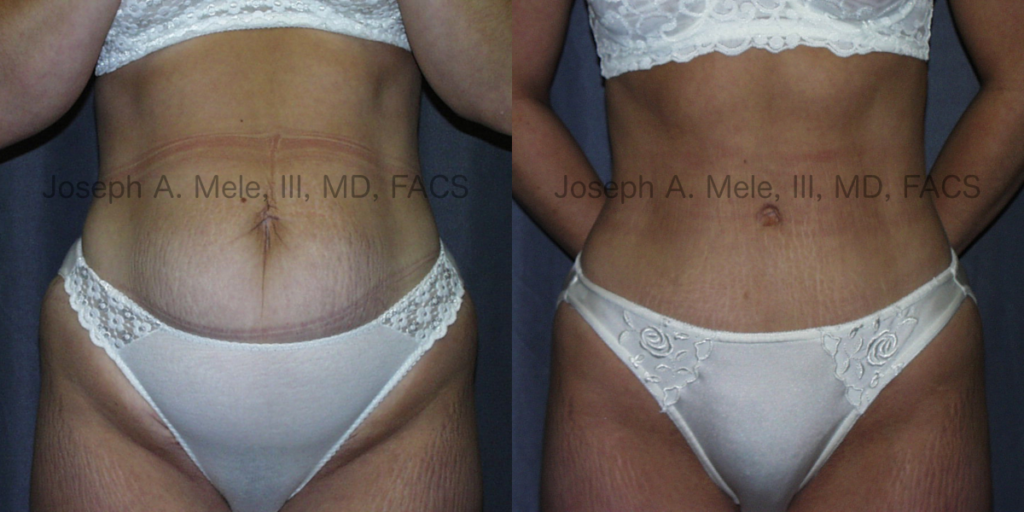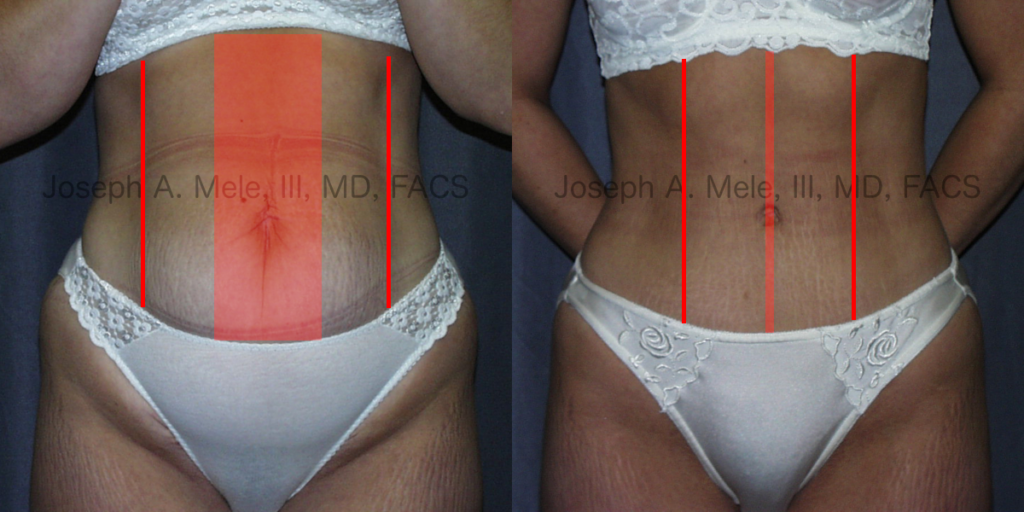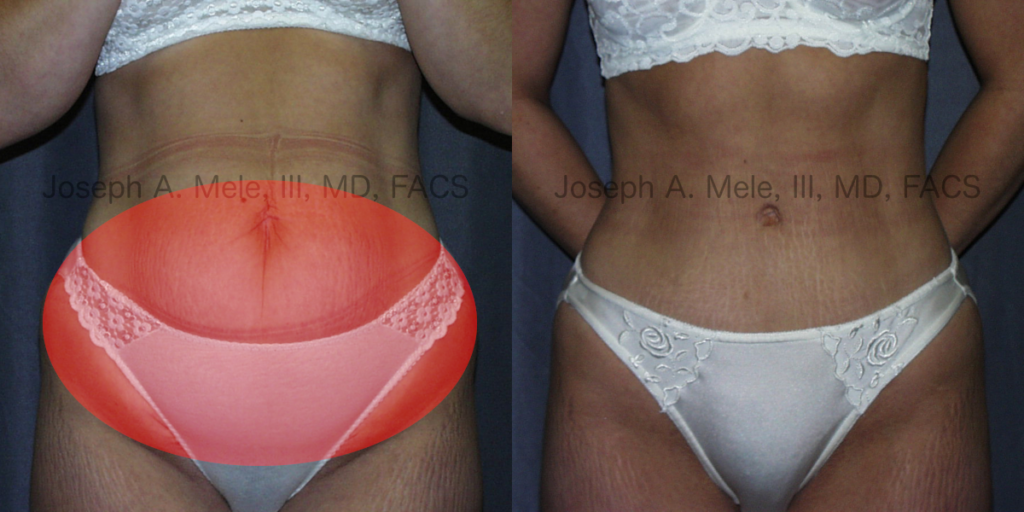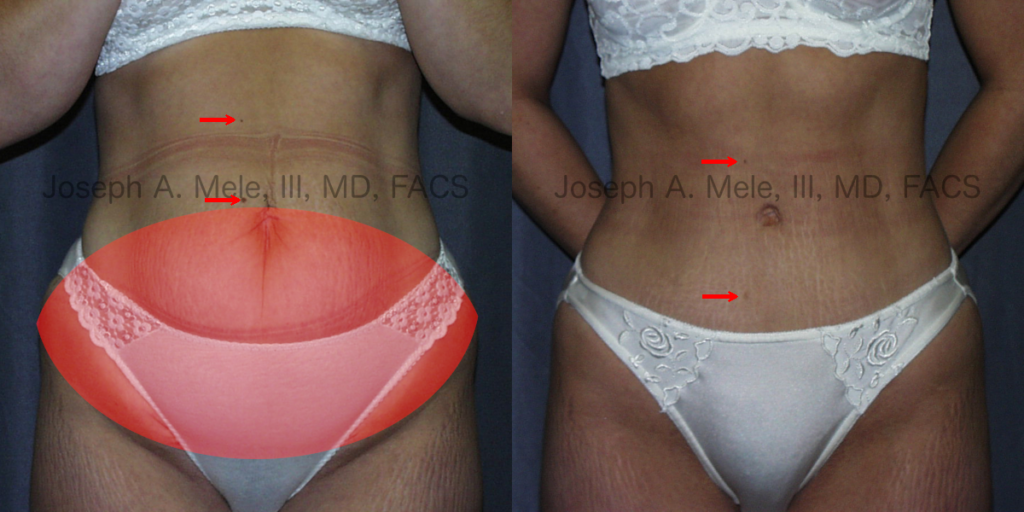The Tummy Tuck is one of the most useful and popular cosmetic plastic surgery procedures for patients that wish to restore a flat belly. It helps mommies after childbearing and anyone who has lost a significant amount of weight, especially with loose abdominal skin.

The Tummy Tuck tightens abdomen muscles and removes excess belly skin, as these Abdominoplasty before and after pictures reveal.
What Is A Tummy Tuck?
Everyone knows a Tummy Tuck tightens the tummy, but how is it done? There are three main components to Abdominoplasty. From the inside out they are:
- Muscle wall tightening
- Removal of disproportionate fat
- Excision of redundant skin
Abdominoplasty – Muscle Wall Tightening
The foundation of the Tummy Tuck is the muscle repair. The anterior surface of the muscle is exposed during abdominoplasty, and that is where the repairing begins.
With pregnancy and weight gain, the abdominal muscles are stretched, including the tough fascial case that surrounds the muscles. During the Tummy Tuck, the muscle case is tightened directly. Sutures are placed into the fascia like an internal corset.

Tummy Tucks tighten the abdominal muscle fascia. The red areas show repair of the diastasis and movement of the rectus muscles to the midline.
Although the muscle repair is internal, the results can be seen through the skin. In the Tummy Tuck Before and After Pictures above, the evidence is clear. The wide central band represents the diastasis in the muscles — a separation of the muscles caused by the over-stretching abdominal wall that occurs with pregnancy or weight gain. Internal sutures plicate the diastasis and bring the muscles back together, as is represented by the central line of repair in the after photo. The lateral, darker red lines show the outer edge of the rectus abdominis muscles. Before plication, they are wide and on the sides. After plication, they are moved toward the midline and back to their normal anatomic position — front and center.
Abdominoplasty – Removal of Disproportionate Fat
Fat accumulates primarily under the skin of the lower abdomen. This is the first place that weight is deposited and the last place it leaves. When the lower abdominal skin is excised during a tummy tuck, the fat beneath is also removed. For optimal results, Liposuction is often used to remove extra fat from the sides, flanks and back — areas where the skin is not excised.

Abdominoplasty removes the disproportionate fat from the lower abdomen. The area highlighted in red is where fat can be safely removed.
The red oval in the Abdominoplasty before picture above highlights where fat can be safely removed. Fat on the waistline, or on the skin that remains after surgery, may need to be removed at a second operation if removal during Abdominoplasty might jeopardize the blood supply to the new, flattened belly.
Abdominoplasty – Excision of Redundant Skin
My favorite part of the Tummy Tuck is removing redundant skin. This pesky roll of skin does not get better with exercise, and weight loss just deflates it, so it hangs more. It is very frustrating for my patients, but very satisfying for me to fix.
The red lens shape in the before picture below approximates the area of skin was removed during this tummy tuck. This patient had a previous C-section with a scar that caused a deep, unsightly dent in her lower abdomen. The C-section scar was removed along the loose skin and excess fat. The result is a happy patient with a toned, flat belly.

Abdominoplasty – removes any excess skin from the lower abdomen. The skin highlighted in red was removed. The upper abdominal skin is stretched, as can be seen by the movement of the two moles marked with the red arrows in the before and after pictures.
The umbilicus (belly-button) is not removed. In this case, the area around the umbilicus was stretched out and deformed from pregnancy and previous surgery. The central circular umbilicus was preserved and remained attached to the muscular abdominal wall to preserve its circulation. During the Abdominoplasy the skin was pulled down, and a new button-hole was made to recreate a more youthful and rejuvenated belly-button.
The skin above the umbilicus is stretched and smoothed as part of the Abdominoplasty. The amount of stretch is demonstrated by a couple of moles on the skin. In the Abdominoplasty Before and After Pictures above, the moles are marked with red arrows. The upper one moves halfway to the umbilicus. The lower one starts at the belly-button and moves most of the way down the abdomen.
Tummy Tuck Consultations
The results of tightening the muscle, removing excess fat and excision of loose skin speak for themselves. I hope this helps you better understand what your Plastic Surgeon is up to during an Abdominoplasty.
When considering a Tummy Tuck, be sure to seek an experienced, Board Certified Plastic Surgeon who understands your needs and explains how to get there. In the San Francisco Bay Area call (925) 943-6353 to schedule a private consultation appointment and learn what Abdominoplasty can do for you.
Previous Post Next Post